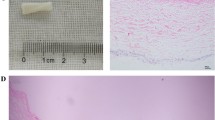Abstract
BACKGROUND:
Bile duct injury (BDI), which may occur during cholecystectomy procedures and living-donor liver transplantation, leads to life-altering complications and significantly increased mortality and morbidity. Tissue engineering, as an emerging method, has shown great potential to treat BDI. Here, we aimed to explore the application of small intestinal submucosa (SIS) matrix composites with bone marrow mesenchymal stem cells (BMSCs) to treat BDI in a rabbit model.
METHODS:
Rabbit-derived BMSCs were used as seed cells. Porcine SIS was used as the support material. Five centimetres of the common bile duct was dissected, and 1/3–1/2 of the anterior wall diameter was transversely incised to construct the rabbit BDI model. Then, SIS materials without/with BMSCs were inserted into the common bile duct of the BDI rabbits. After 1, 2, 4, and 8 weeks of implantation, the common bile duct was removed. Haematoxylin and eosin (HE) staining was used to assess pathological alterations in the common bile duct, while immunohistochemical staining and western blotting were used to detect expression of the epithelial cell markers CK19 and E-cadherin. Scanning electron microscopy was used to evaluate BMSC growth.
RESULTS:
Compared with BMSCs alone, SIS-attached BMSCs had increased growth. HE staining showed that the injured bile duct healed well and that the complex gradually degraded as the time from implantation increased. Immunohistochemical staining and western blotting showed that compared with the control group, the in vivo complex group had significantly elevated expression levels of CK19 and E-cadherin.
CONCLUSION:
BMSC implantation into SIS could improve BDI in rabbits, which might have clinical value for BDI treatment.




Similar content being viewed by others
References
Lau WY, Lai EC, Lau SH. Management of bile duct injury after laparoscopic cholecystectomy: a review. ANZ J Surg. 2010;80:75–81.
Buddingh KT, Weersma RK, Savenije RA, van Dam GM, Nieuwenhuijs VB. Lower rate of major bile duct injury and increased intraoperative management of common bile duct stones after implementation of routine intraoperative cholangiography. J Am Coll Surg. 2011;213:267–74.
Pekolj J, Alvarez FA, Palavecino M, Sánchez Clariá R, Mazza O, de Santibañes E. Intraoperative management and repair of bile duct injuries sustained during 10,123 laparoscopic cholecystectomies in a high-volume referral center. J Am Coll Surg. 2013;216:894–901.
Maeda A, Yokoi S, Kunou T, Saeki S, Murata T, Niinomi N, et al. Bile duct cancer developing 21 years after choledochoduodenostomy. Dig Surg. 2003;20:331–4.
Bettschart V, Clayton RA, Parks RW, Garden OJ, Bellamy CO. Cholangiocarcinoma arising after biliary-enteric drainage procedures for benign disease. Gut. 2002;51:128–9.
Silva SS, Motta A, Rodrigues MT, Pinheiro AF, Gomes ME, Mano JF, et al. Novel genipin-cross-linked chitosan/silk fibroin sponges for cartilage engineering strategies. Biomacromolecules. 2008;9:2764–74.
Sharma AK, Hota PV, Matoka DJ, Fuller NJ, Jandali D, Thaker H, et al. Urinary bladder smooth muscle regeneration utilizing bone marrow derived mesenchymal stem cell seeded elastomeric poly(1,8-octanediol-co-citrate) based thin films. Biomaterials. 2010;31:6207–17.
Baudis S, Nehl F, Ligon SC, Nigisch A, Bergmeister H, Bernhard D, et al. Elastomeric degradable biomaterials by photopolymerization-based CAD-CAM for vascular tissue engineering. Biomed Mater. 2011;6:055003.
Ahn HH, Kim KS, Lee JH, Lee MS, Song IB, Cho MH, et al. Porcine small intestinal submucosa sheets as a scaffold for human bone marrow stem cells. Int J Biol Macromol. 2007;41:590–6.
Abraham GA, Murray J, Billiar K, Sullivan SJ. Evaluation of the porcine intestinal collagen layer as a biomaterial. J Biomed Mater Res. 2000;51:442–52.
Hayashi T, Nagai Y. Separation of the alpha chains of type I and III collagens by SDS-polyacrylamide gel electrophoresis. J Biochem. 1979;86:453–9.
Woessner JF Jr. Determination of hydroxyproline in tissue and protein samples containing small proportions of this amino acid. Arch Biochem Biophys. 1961;93:440–7.
Li X, Yuan Z, Wei X, Li H, Zhao G, Miao J, et al. Application potential of bone marrow mesenchymal stem cell (BMSCs) based tissue-engineering for spinal cord defect repair in rat fetuses with spina bifida aperta. J Mater Sci Mater Med. 2016;27:77.
Zhang Y, Lin HK, Frimberger D, Epstein RB, Kropp BP. Growth of bone marrow stromal cells on small intestinal submucosa: an alternative cell source for tissue engineered bladder. BJU Int. 2005;96:1120–5.
Lin HK, Godiwalla SY, Palmer B, Frimberger D, Yang Q, Madihally SV, et al. Understanding roles of porcine small intestinal submucosa in urinary bladder regeneration: identification of variable regenerative characteristics of small intestinal submucosa. Tissue Eng Part B Rev. 2014;20:73–83.
Acknowledgements
We thank The youth fund of Southwest Medical University (No. 2018-ZRQN-096) for providing support for the study.
Author information
Authors and Affiliations
Corresponding authors
Ethics declarations
Conflict of interest
The authors declare that they have no conflict of interest.
Ethical statement
This study was approved by the Institutional Review Board of the Southwest Medical University (SWMU) (No. SWMU20180306059).
Additional information
Publisher's Note
Springer Nature remains neutral with regard to jurisdictional claims in published maps and institutional affiliations.
Rights and permissions
About this article
Cite this article
Li, Y., Wang, P., Hu, Xd. et al. Implantation of Bone Marrow Mesenchymal Stem Cells into Small Intestinal Submucosa Improves Bile Duct Injury in Rabbits. Tissue Eng Regen Med 18, 887–893 (2021). https://doi.org/10.1007/s13770-021-00351-2
Received:
Revised:
Accepted:
Published:
Issue Date:
DOI: https://doi.org/10.1007/s13770-021-00351-2




